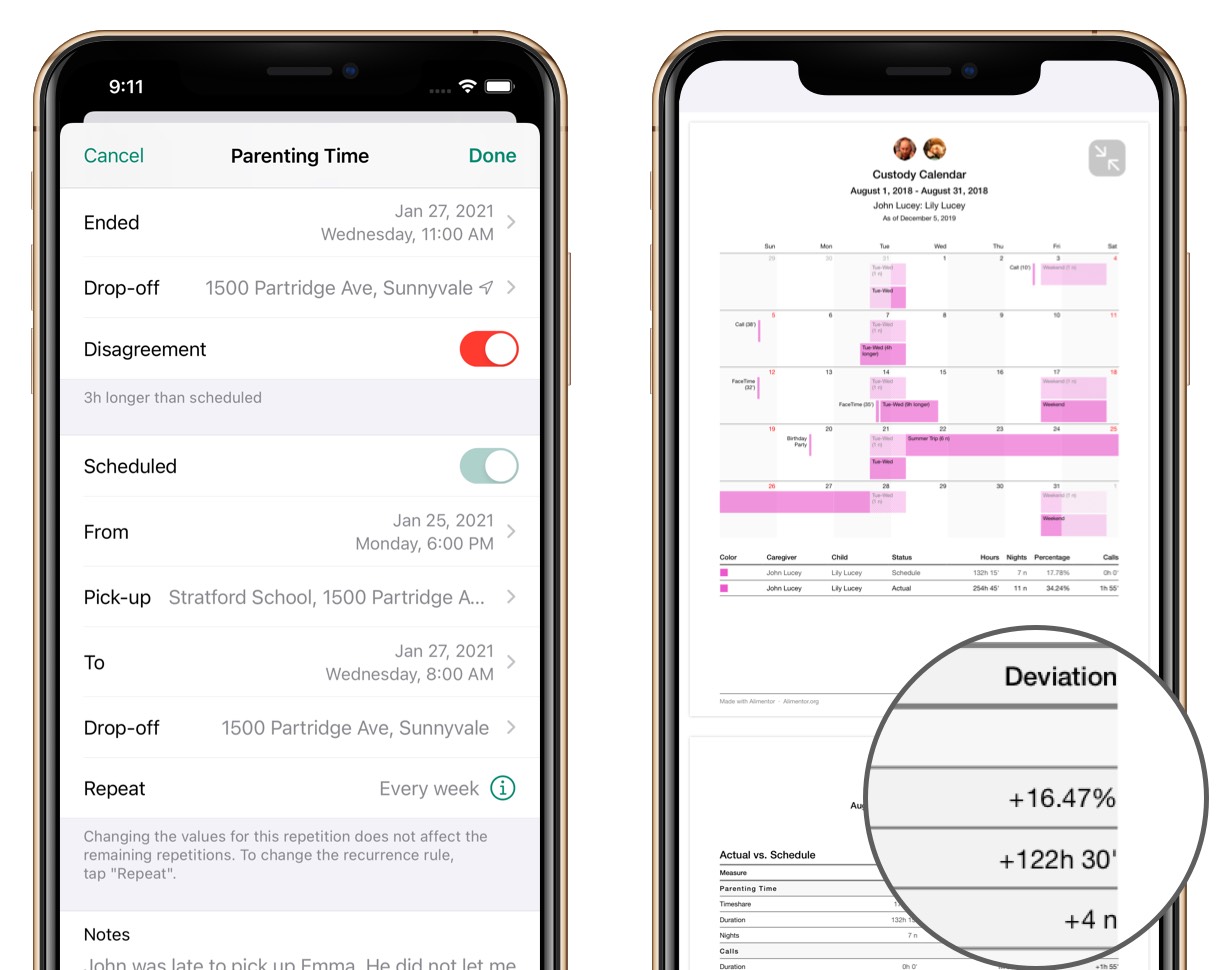How to Create an Optimum Parenting Schedule
Learn how to create your optimum custody schedule and how Alimentor can support your planning habits.

Learn how to create your optimum custody schedule and how Alimentor can support your planning habits.

Children need routines and predictability. Knowing in advance when they will stay with each parent will certainly help them deal better with parents separation.
Your offspring had both of you before the divorce and you should think rationally about what’s best for them and what is possible for you post‑divorce.
To make sure that you can spend the right amount of time with your children, increase their emotional security and minimize conflicts with other commitments, you need to plan ahead.
In many jurisdictions, a formal Parenting Plan is part of the Divorce Agreement. In other jurisdictions, there is no formal requirement, but it is one of the most important elements of your divorce as it involves your child(ren)’s well‑being.
Taking the initiative and proposing a detailed visitation calendar for the coming months will significantly increase the chances of establishing a potentially optimum schedule.
Planning ahead can help you realize limitations and obstacles that are difficult to spot until you actually try to come up with a detailed parenting time schedule. It helps you confront your aspirations with what is actually possible.
If you have current conflict, based on the divorce, it can be difficult to think clearly about how this looks to your children.
It’s a critical mistake, however, not to do so. It’s clear most kids, and most parents, benefit from some form of shared custody. That’s worth repeating: Kids thrive when they spend time with and are cared for by both of their parents, even when both parents live apart after a divorce.
It’s not the divorce that hurts kids but the conflict between their parents. So, in addition to sharing parenting time, it’s important to manage the entire process from scheduling to drop‑offs and pick‑ups so that your children do not feel the conflict that may exist between you and your ex.
Finding the right balance between parenting, work and relationships with family and friends can be challenging. But it is always better to make informed and timely decisions based on mutual agreement than to procrastinate and keep coming up with the last‑minute solutions.
To be able to come up with an optimum schedule, you need to make sure that your calendar contains all important events that need to be taken into account when planning your time.

The amount of time you spend with your child is known as “custodial timeshare”. In many jurisdictions to has a direct impact on the amount of child support you pay or receive.
While the final custody percentage may differ from your initial estimate, starting with a realistic target helps narrow down options and makes it easier to develop an optimal visitation schedule.
In this step, envision as realistically as possible what timeshare percentage can work for your specific circumstances. A 50/50 parenting schedule works well for many, but it may not be suitable for all families.
Begin by reviewing your calendar for the upcoming month and counting the days when you can care for your children.
The recommended frequency of transitions depends on the age of your child. A younger child may do better with frequent visits with both parents (rotation every 2 days), while older children may find it easier to manage less frequent changeovers.
If travel is an issue for one or both of you, it may be necessary to think through a plan before implementing a particular schedule.
Based on what you already know, try to decide how you want the schedule to rotate.
One advantage of the 2-2-5-5 schedule is having your child(ren) consistent days of the week, that is, you will always have Mondays and Tuesdays or Wednesdays and Thursdays, for example, which allow you to schedule particular lessons or events for consistent days that they are with you. The disadvantage is a relatively short time period between transition, so it may be more practical with younger children unless your tweens and teens don’t mind the shuttling around part very much.
The level of cooperation between you and your co-parent plays a significant role in determining the best schedule for your child. If you have a positive and cooperative relationship, you may have the flexibility to make almost any schedule work. However, if your relationship is strained and unlikely to improve, you might need a more structured and specific schedule to reduce direct contact and potential conflicts.
For instance, you could arrange to pick up and drop off your child at a neutral location, such as their school or an extracurricular activity, to avoid unnecessary face-to-face interactions. This approach can help minimize tension and make exchanges smoother.
Regardless of the relationship dynamics, maintaining flexibility is crucial. Flexibility helps diffuse any existing tension between you and your ex-partner and keeps your child(ren) from being caught in the middle of conflicts. By being adaptable, you can create a more stable and less stressful environment for your child(ren), which is ultimately in their best interest.
This step explains how to model your parenting schedule to see how it aligns with your preferences and existing obligations. It will also help you calculate the custodial timeshare percentage, which plays a significant role in determining child support.
Use recurring events to create a regular visitation schedule for one parent.
Adjust the recurrence settings until you’re satisfied with the resulting dates and timeshare percentage. Ensure that your decisions positively impact your children’s well-being.
In addition to the regular schedule, consider how holidays, vacations, and other school breaks will fit into your plan. These details should be part of your Parenting Agreement. Co‑parents often alternate holidays and school breaks annually or find an arrangement that works best for them and their children. The key is to develop a plan that minimizes conflict and works for everyone involved.
Review the upcoming months to identify any conflicts with work or other important events. Decide how you can reschedule visits that require individual adjustments.
When editing individual visitations, always check how these changes affect your overall timeshare percentage.
Accurately calculating your custodial timeshare, also known as custody percentage, is essential in child custody arrangements. This calculation depends on knowing the exact number of hours (or nights) the children spend with each parent.
In Alimentor, two different bases are used for timeshare calculations:
Alimentor also allows you to generate reports that compare timeshares:
These percentages are displayed in two sections of the report: “Calendar” and “Summary”.
For documentation and presentation purposes, the calendar in Alimentor reports can be configured to automatically allocate unassigned parenting time. Based on the logged time for one parent, the app can assign any remaining unallocated time to the other parent or designated caregiver.
Review the calculated custody percentage to ensure it aligns with your expectations. If it doesn’t, consider adjusting your schedule to achieve the desired timeshare.
To successfully implement a co-parenting custody schedule, it’s essential to share and discuss it thoroughly with the other parent and, if necessary, with other caregivers.
You might also consider asking the other parent to use Alimentor to create their preferred custody schedule and then exchange data to compare and align your proposals.
To help you document and manage any discrepancies between the agreed-upon custody schedule and what actually occurs, Alimentor allows each record to store both the planned and actual visitation dates and times.

If you have any questions about Alimentor, or want to share your feedback, please email us at: feedback@alimentor.org.